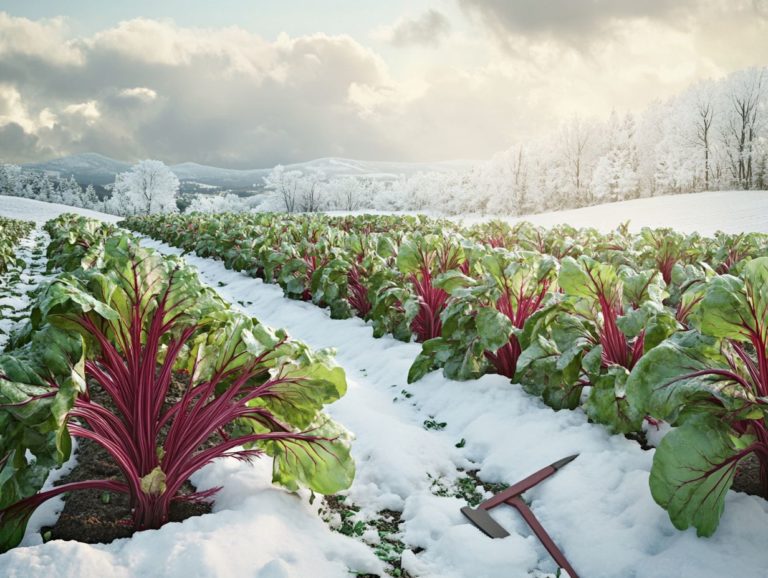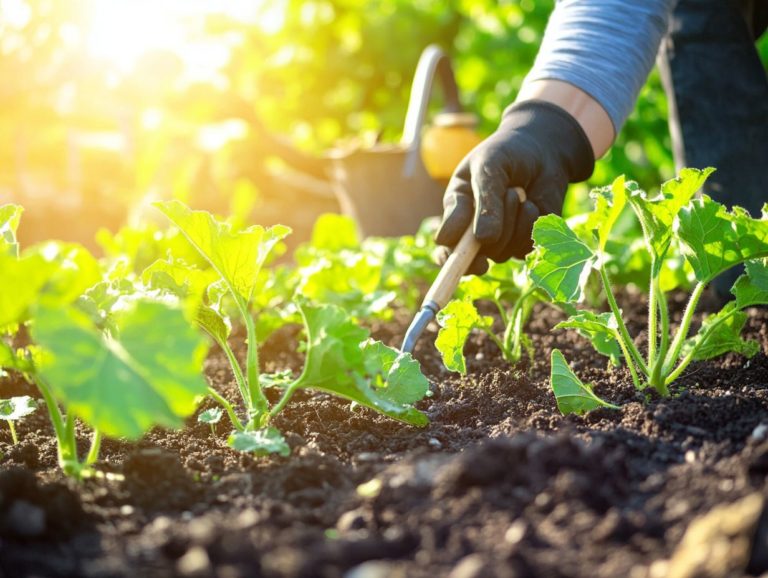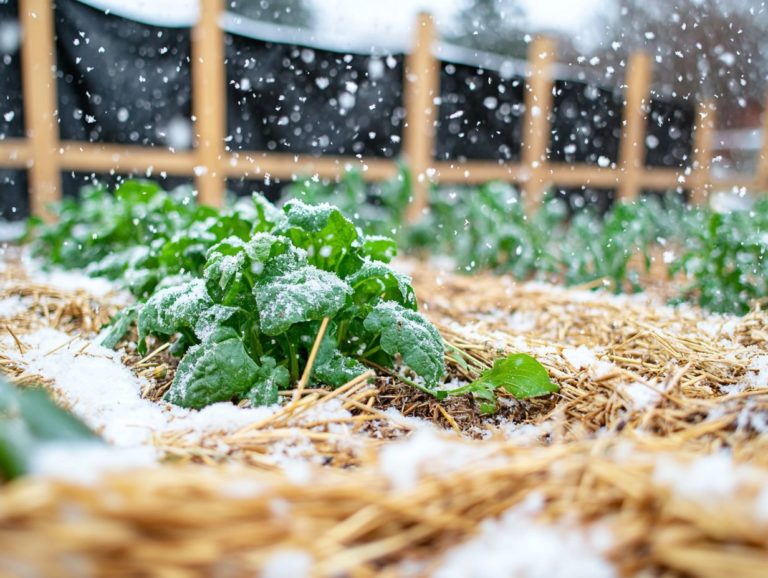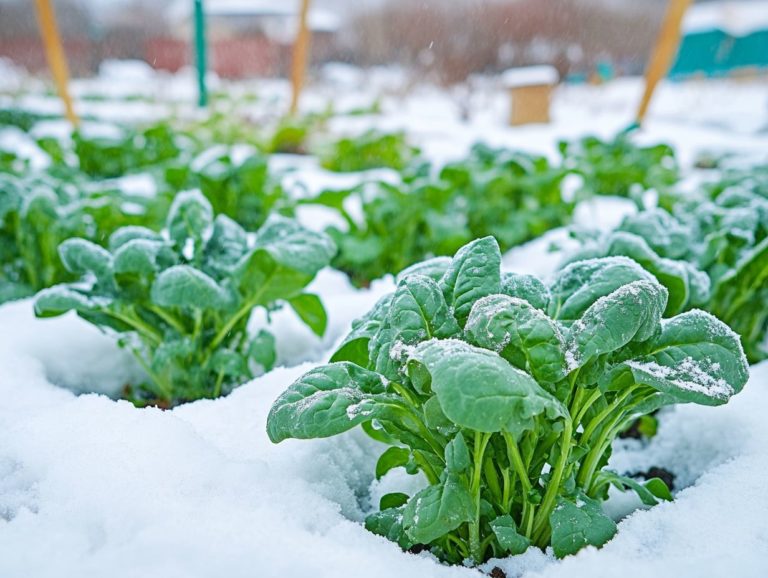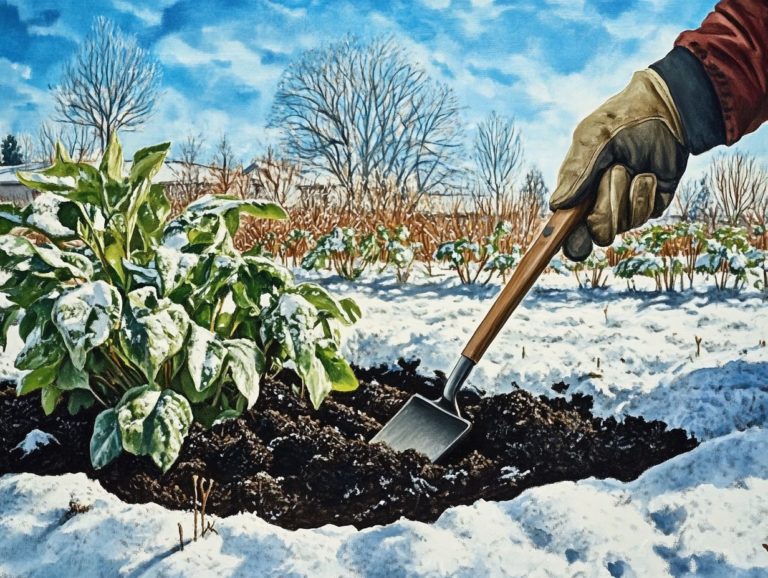Essential Equipment for Winter Crop Care
As winter draws near, prioritizing the health and productivity of your crops is crucial!
This guide explores essential aspects of winter crop care. It covers everything from protecting your crops against harsh conditions to optimizing your irrigation and heating systems. You ll find the essential tools and equipment every farmer should have, along with effective monitoring and safety measures.
Whether you’re looking to refine your harvesting techniques or improve your storage solutions, this article offers valuable insights to help you navigate the challenges of winter agriculture.
Contents
- Key Takeaways:
- 1. Winter Crop Protection
- 2. Irrigation Systems
- 3. Heating and Insulation
- 4. Lighting Systems
- 5. Harvesting Equipment
- 6. Best Practices for Storing and Transporting Winter Crops
- 7. Crop Monitoring and Management Tools
- 8. Safety Equipment
- 9. Equipment Maintenance and Repair
- Frequently Asked Questions
- What is considered essential equipment for winter crop care?
- Do I need to invest in specialized equipment for winter crop care?
- How often should I use my equipment for winter crop care?
- Are there any safety precautions I should take when using equipment for winter crop care?
- Can I rent equipment for winter crop care instead of purchasing it?
- What should I do with my equipment after winter crop care season is over?
Key Takeaways:
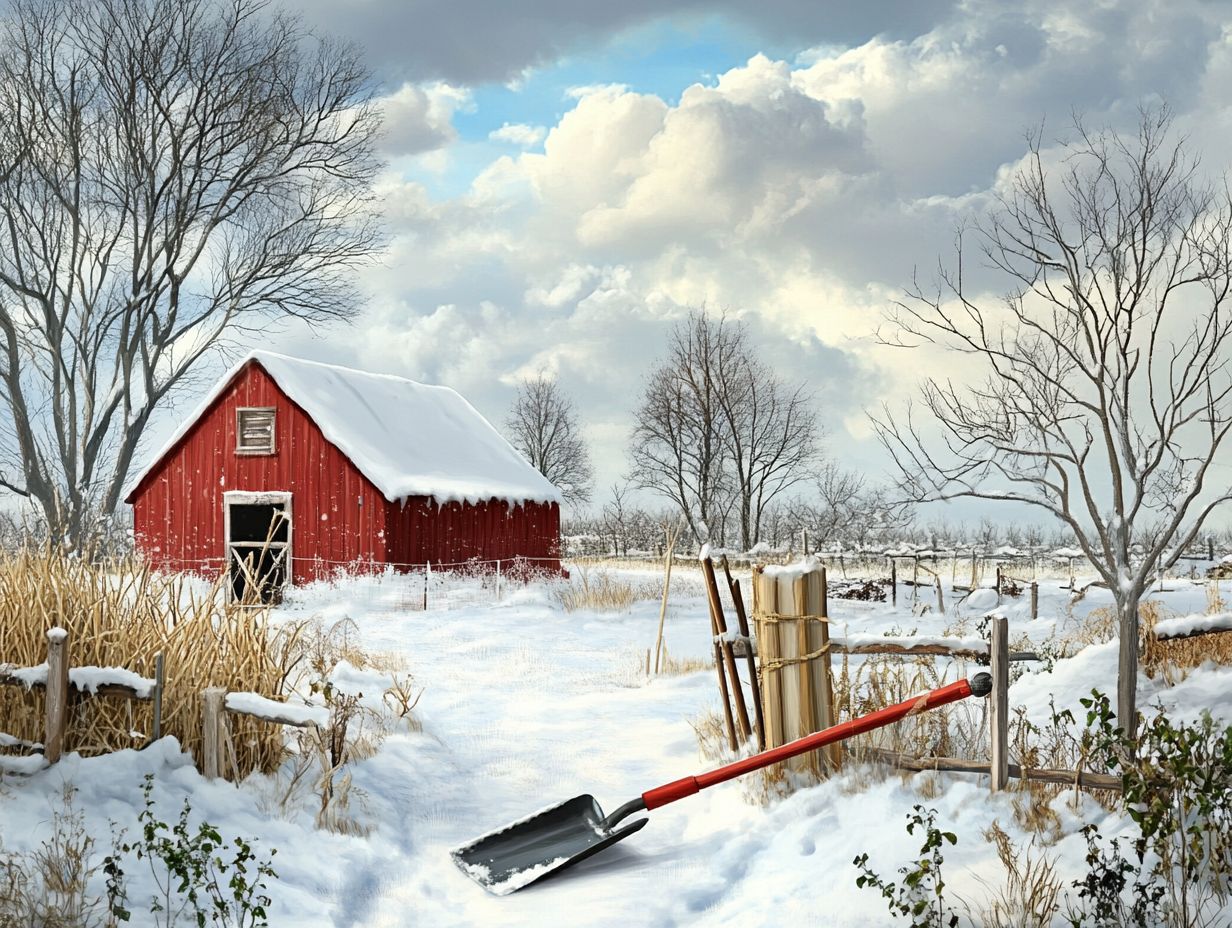
- Proper irrigation is crucial for winter crops to maintain moisture levels and prevent freezing damage.
- Heating and insulation equipment is necessary to protect winter crops from extreme temperatures.
- Regular maintenance and repair of equipment are essential for successful winter crop care.
1. Winter Crop Protection
In winter gardening, protecting your crops is essential. They face unique challenges from cold temperatures and frost that threaten their growth and yield, making the role of greenhouses in winter crop care crucial for success.
Employ effective methods like cold frames, row covers, and hoop houses to significantly enhance your crops’ chances of survival. These methods extend your growing season and help you choose the right vegetable varieties for your local climate, making winter crop preservation vital for successful gardening.
These protective structures shield your plants from chilly winds and snow, while creating a microclimate that retains warmth and humidity crucial for your hardy plants.
Many growers position cold frames or use hoop houses to trap heat during sunny winter days, while row covers act as a lightweight barrier against frost. Choose resilient varieties like kale, spinach, and carrots for a bountiful harvest even in frigid temperatures!
Familiarizing yourself with local frost dates, planting dates, and hardiness zones helps you make informed decisions about planting and crop selection, promoting a thriving organic garden throughout the year.
What Are the Main Threats to Winter Crops?
Winter crops face various threats that can compromise their health and yield, including frost, pests, and diseases. Taking a proactive approach is essential for managing these challenges, especially in unforgiving climates like Utah.
Temperature fluctuations and heavy snowfall can lead to frost damage in vulnerable crops. Meanwhile, lingering moisture may foster fungal diseases that thrive in damp conditions. Certain pests, like aphids and root maggots, might seem dormant but can suddenly disrupt your winter plantings.
Regularly inspect your plants and soil for early signs of distress. Employ strategies like crop rotation and organic pest control methods to mitigate risks in your vegetable gardens.
Protective measures, such as row covers, provide an extra layer of insulation against frost. Ensure your winter harvests are robust and resilient!
How Can You Protect Your Winter Crops?
Protecting your winter crops effectively means adopting a variety of techniques. Use cold frames, row covers, and other ways to protect plants from frost. By implementing these strategies, you can significantly increase your chances of successful winter gardening.
Enjoy a bountiful harvest come spring! To get started, consider setting up cold frames. These simple structures trap heat from the sun, creating a warmer microclimate for your plants. You can easily construct them using old windows or opt for ready-made kits. They’re perfect for starting seedlings or nurturing greens through the chill.
Row covers also play a vital role. They act as cozy blankets, insulating your plants while still permitting light. Make sure to secure the covers properly to prevent the wind from whisking them away. Remember to lift them occasionally to allow humidity and air circulation.
Using mulch helps maintain soil temperature and retain moisture. This strategy combats challenging elements and encourages healthy growth throughout the winter months.
Essential Tools for Protecting Your Winter Crops
Essential tools for winter crop protection include cold frames, hoop houses, and row covers. These tools are vital for shielding your plants from the cold and ensuring their survival through the winter months, as detailed in the ultimate guide to winter crop care.
Cold frames are like miniature greenhouses. They allow sunlight to warm the soil and your plants while providing a protective barrier against harsh winds and frost. Hoop houses, on the other hand, are larger structures made from arches and plastic sheeting. They create a stable microclimate that offers extensive protection for your larger plots.
Row covers, crafted from lightweight fabric, serve as blankets for your individual plants. They insulate them while still allowing light and moisture to seep through. Beyond these essential tools, you can diversify your strategies by incorporating mulch for soil insulation.
Consider using heat mats to maintain optimal root temperatures. Together, these resources create an environment that not only defends against extreme conditions but also fosters growth, ensuring your winter crops flourish.
2. Irrigation Systems
Irrigation systems play a crucial role in ensuring that your winter crops receive the moisture they need. This is particularly important in regions like Utah, where temperature swings can wreak havoc on soil health and plant care during the winter months.
Without a proper irrigation setup, your vegetable gardens may fall victim to drought stress, jeopardizing the growth potential of your winter crops. Understanding moisture management is essential for maintaining both yield and quality.
Effective irrigation practices do more than just prevent drought-related challenges; they also help reduce the risks associated with excessive moisture, like root rot.
You have a range of irrigation options at your disposal:
- Drip irrigation
- Soaker hoses
- Sprinkler systems
Each option offers distinct advantages tailored to your specific planting layouts and crop types. Keeping these systems in tip-top shape involves regular checks for leaks, careful scheduling to avoid overwatering, and ensuring that your water source remains clean and free from contaminants.
By implementing a smart irrigation strategy, you set the stage for healthier plants and sustainable gardening throughout the colder months.
Why Is Irrigation Important for Winter Crops?
Irrigation is essential for your winter crops. It ensures they get the moisture they need to thrive. This prevents stress and fosters healthy growth, even when temperatures drop. By grasping the significance of irrigation, you can elevate your winter gardening game and boost your crop yields.
Maintaining optimal moisture levels is crucial, especially when winter precipitation might be lacking. This is where strategic irrigation practices come into play, enhancing soil structure to retain moisture more effectively.
Take crops like kale and spinach, for instance. They thrive on consistent watering, which keeps them vibrant and healthy. Proper irrigation techniques shield your plants from dehydration and minimize the risk of frost damage, a foe that can wreak havoc on a winter garden.
Ultimately, by prioritizing effective irrigation strategies, you can ensure your winter vegetable gardens not only survive but also flourish. This leads to bountiful harvests even in the face of challenging weather conditions, enhancing your gardening education!
Start implementing these strategies today for a thriving winter garden!
What Types of Irrigation Systems Are Best for Winter Crops?
Choosing the right irrigation systems for your winter crops can truly transform your gardening experience. It ensures that your plants receive the moisture they need throughout the growing season. Consider options like drip irrigation and soaker hoses; these methods deliver water straight to the soil, cutting down on evaporation and maximizing efficiency.
Surface irrigation is another option to consider. However, it often leads to uneven water distribution and potential runoff, which isn t ideal. On the other hand, sprinkler systems can quickly cover larger areas but may inadvertently increase moisture on leaves, setting the stage for disease during those cold months.
Each irrigation method comes with its own set of perks think cost-effectiveness or ease of installation as well as some drawbacks, such as maintenance needs. To make the most of these systems in your winter gardening endeavors, make it a habit to check your soil moisture regularly for the best results! Adjust your watering schedules based on the ever-changing environmental conditions.
How Can You Maintain Your Irrigation System in the Winter?
Maintaining your irrigation system during the winter is vital to ensure it operates effectively when the growing season rolls back around. Regular checks and winterizing techniques can prevent damage and facilitate a seamless transition to active use in the spring, which is crucial for successful winter crop gardening and garden maintenance.
To begin, draining any residual water from the system is essential; this prevents pipes from freezing and bursting under harsh winter conditions. Insulating exposed pipes or applying heat tape can provide an added layer of protection against the cold. Conducting routine inspections before winter arrives allows you to catch potential issues early in your garden planning, ultimately saving you time and money down the road.
It’s a smart move to clean filters and flush the system, eliminating any debris that could impede performance when spring planting or fall garden planting arrives. Regular maintenance saves money and improves crop health, protecting the integrity of your irrigation system and positively impacting the overall health and yield of your winter crops.
3. Heating and Insulation
Heating and insulation are essential for cultivating successful winter crops, especially in colder climates where temperatures can drop significantly, impacting the growth and yield of hardy plants. By employing strategies such as hoop houses and other cold-weather methods, you can create a favorable microclimate a small area with different weather conditions than its surroundings that protects your garden from freezing temperatures, ensuring your crops not only survive but thrive throughout the winter months.
To unlock their full potential, explore various gardening resources and heating options available. Consider passive solutions, which mean using natural methods to keep plants warm, like solar gain through clear coverings, or more active methods such as electric or propane heaters that are beneficial for indoor gardening. Insulation plays a dual role; it not only traps warmth but also shields your crops from harsh winds, which is crucial for maintaining an optimal growing environment. Simple techniques like layering straw or using floating row covers can significantly enhance your insulation.
For those eager to elevate their winter gardening game, here are some practical gardening tips to keep in mind:
- Regularly monitor temperatures to stay ahead of the cold.
- Utilize thermal mass, such as stones, to store heat effectively.
- Research local resources or gardening clubs focused on seasonal crop cultivation.
By skillfully combining these heating and insulation strategies, you can ensure robust yields even in the coldest months. Don’t wait until the last minute; start preparing your irrigation system now for a thriving spring garden! Implement these strategies today and watch your winter garden flourish!
Why Is Heating Necessary for Winter Crops?
Heating is essential for your winter crops. It maintains optimal temperatures, ensuring that your plants continue to grow and develop, even when they are vulnerable to frost and cold stress.
By providing adequate heat, you can effectively extend your growing season and significantly enhance your overall yields.
Certain varieties, like kale, spinach, and winter lettuce, thrive in warmer conditions, even when outdoor temperatures plummet. Heat facilitates vital processes such as germination and nutrient absorption, both crucial for the health of these crops.
When you manage temperatures appropriately, these plants can photosynthesize more efficiently. This results in lush foliage and greater resilience against pests and diseases, which is vital for organic gardening.
Stable heat levels enhance the flavor profiles of your winter crops, making them more appealing to consumers.
In the grand scheme of things, the importance of heating in winter cultivation cannot be overstated. It is the key to achieving both healthy plants and bountiful harvests.
What Are the Different Heating Options for Winter Crops?

There are various heating options available for your winter crops. These range from passive methods, like using thermal mass heavy materials like stone that store heat and release it slowly to active heating systems such as electric mats or heating cables.
Each option plays a crucial role in protecting your plants from freezing temperatures. By understanding these methods, you can determine the most suitable one tailored to your specific gardening needs and climate conditions.
Consider factors like your local climate and the unique requirements of your crops to make informed decisions. For instance, employing thermal mass offers a steady, slow release of heat, which is perfect for moderate, stable environments.
Conversely, electric heating mats provide precision and control, making them ideal for temperature-sensitive seedlings.
If you re looking to encourage faster growth, heating cables can be integrated into the soil or potting mix to deliver warmth directly to the root zone.
As you select a heating method, evaluate your available space, energy resources, and budget to ensure optimal results during the colder months in your home gardening efforts.
How Can You Properly Insulate Your Winter Crops?
Insulating your crops is crucial for their survival! Proper insulation helps maintain consistent temperatures and protects your plants from harsh weather conditions and frost.
Techniques like using straw bales, bubble wrap, or specialized gardening blankets can effectively insulate your crops, including carrots and beets, ensuring they survive through the winter.
Along with these methods, row covers can offer an extra layer of warmth by trapping heat from the soil while shielding your plants from wind and frost.
Consider creating a cold frame, which uses transparent materials to capture sunlight while minimizing heat loss during the night.
As you explore these techniques, remember that proper ventilation is essential. Too much heat can lead to mold growth, posing one of the common gardening challenges.
Evaluate the specific needs of your plants and their resilience to cold temperatures. You must tailor these strategies to boost your chances of achieving healthy growth and vibrant yields come spring!
4. Lighting Systems
Winter crops need extra lighting because shorter days mean less natural light. Effective lighting is essential for successful indoor gardening and seed starting.
Proper lighting stimulates plant growth and creates a healthy environment for winter crops. It ensures they get the light energy required to thrive in colder months.
Choosing the right lighting system is crucial. For instance, LED grow lights are energy-efficient and provide a full spectrum for robust growth.
Fluorescent lights are excellent for seedlings and easy to set up. You must position the lights at the right distance not too close or too far from the plants.
Understand the specific needs of your crops to determine the best timing and duration for light exposure. Learning about plant care can help you optimize your setup.
Why Do Winter Crops Need Additional Lighting?
Winter crops need more light because of limited daylight hours and lower sunlight intensity. Artificial light helps ensure your plants receive the energy to thrive.
Crops like spinach, lettuce, and kale rely on light for growth. Without enough light, they can develop elongated stems and poor-quality leaves.
Supplemental lighting mimics longer days, boosting growth and enhancing the nutritional value of winter crops. This approach can significantly improve your vegetable harvest.
What Types of Lighting Systems Are Best for Winter Crops?
Choosing effective lighting systems is key to providing adequate light exposure for winter crops. LED grow lights and fluorescent lamps are both efficient options for indoor gardening.
LEDs are especially attractive due to their low energy use and long lifespan, often lasting up to 25,000 hours. This makes them a cost-effective choice for home gardeners.
Fluorescent lamps may offer a lower initial investment, making them suitable for smaller setups. Evaluate your needs and available space to choose the best option.
Maximize your lighting coverage while minimizing shadows. Using timers and sensors can optimize energy use without compromising plant health.
How Can You Set Up and Maintain Your Winter Crop Lighting System?
Setting up and maintaining your winter crop lighting system is essential for ensuring your plants receive the consistent and adequate light they need to thrive. Regular checks and adjustments will help you make the system work better and extend the life of your lighting equipment.
To get started, choose the right type of grow lights, whether that be LED or fluorescent, tailored to the specific needs of your crops. Position the lights about 12 to 36 inches above the plants. Adjust them as your plants grow to prevent burning and promote even light distribution.
Timing is key; aim for 12 to 16 hours of light each day, mimicking those glorious summer sunlight hours. Don t forget to regularly inspect your lighting fixtures for dust build-up and replace bulbs as necessary to maintain efficiency. Implementing a timer can automate this process, ensuring your plants receive a consistent light cycle without the hassle.
5. Harvesting Equipment
Harvesting equipment is essential for ensuring that your winter crops are collected efficiently, preserving the quality and taste of seasonal delights like carrots, spinach, and kale. The right tools can streamline your vegetable harvest, making it easier for you to manage your produce while minimizing damage to the plants and maximizing yield.
To truly reap the benefits of proper harvesting, consider investing in tools that make harvesting a breeze, helping you work faster and smarter! These include:
- Handheld pruners
- Harvest bowls
- Garden forks
Using pruners allows for accurate cuts when cutting leafy greens, reducing stress on the plants, while harvest bowls facilitate the transport of delicate vegetables without bruising. Quickly gather crops in the early morning to lock in their moisture and freshness!
Understanding the specific needs of each vegetable type like knowing the perfect moment to pick ripened tomatoes versus frost-hardy greens can significantly enhance the quality of your bounty. This thoughtful approach aligns beautifully with organic gardening principles, fostering a deep respect for the natural growth cycles of your winter crops.
Why Is Harvesting Equipment Important for Winter Crops?
Harvesting equipment is essential for your winter crops, as it allows for the efficient collection of produce, ensuring that vegetables are harvested at their peak quality while preventing loss due to spoilage or damage. The right tools can significantly enhance the overall efficiency of your harvesting process.
When exploring the variety of available tools, consider specialized combine harvesters and mechanical pickers. These remarkable machines are designed to streamline the harvesting of crops like carrots and cabbage. Not only do they accelerate the process, but they also reduce physical labor, enabling you to cover larger areas in less time. The precision of modern harvesting equipment minimizes the risk of bruising or cutting, factors that can negatively impact the shelf life and market appeal of your produce.
By using robust, weather-resistant tools, you can confidently tackle the challenging winter conditions without compromising on quality.
What Are the Essential Harvesting Equipment for Winter Crops?
Essential harvesting equipment for your winter crops should include:
- Hand pruners
- Harvest baskets
- Specialized harvesting knives
These tools streamline the process while ensuring minimal damage to your plants. Selecting the right equipment is crucial for effectively managing your winter vegetable harvest. Investing in quality tools not only boosts efficiency but also significantly impacts the quality of your harvested produce.
For example, hand pruners are critical for cutting leafy greens and herbs with accurate cuts, while sturdy harvest baskets transport your goods without crushing them. Specialized harvesting knives prove invaluable for root vegetables and tougher crops, guaranteeing a clean cut.
When choosing harvesting equipment, consider the specific needs of each crop, such as size, growth pattern, and harvesting technique, as different tools are optimized for different tasks. Evaluate the materials and ergonomics of your tools to enhance your comfort and efficiency during lengthy harvesting sessions.
Get ready and equip yourself with the right tools for a successful winter harvest!
How Can You Properly Use and Maintain Your Harvesting Equipment?
Proper use and maintenance of your harvesting equipment are essential for ensuring its longevity and effectiveness. This allows you to efficiently collect winter crops without compromising quality. Regular cleaning and timely repairs can significantly enhance performance and extend the life of your tools.
Understanding the specific requirements of each type of harvesting tool not only boosts productivity but also minimizes risks. For example, using sharp blades on knives and shears aids in achieving smoother cuts while reducing the chances of slips that could result in injuries.
Don’t miss your chance to inspect your tools! It’s the key to a successful gardening season. Before winter sets in, inspect your tools for any signs of wear and address these issues promptly. By storing your equipment in a dry, sheltered location and applying the right lubricants, you can prevent rust and ensure that your tools are ready for action when the gardening season resumes.
6. Best Practices for Storing and Transporting Winter Crops
Proper storage and transportation of winter crops are essential for maintaining their quality and freshness. This ensures that the vegetables you harvest during the cold months remain viable for consumption or sale. Use the right storage techniques to keep your crops from spoiling and degrading. This helps you maintain their quality.
To optimize the preservation of your winter vegetables, consider employing temperature-controlled environments, like cold storage units and insulated containers, which effectively slow down the degradation process. Tools like burlap sacks and breathable crates boost air circulation, preventing moisture buildup that can lead to rot. Implement best practices, such as washing roots before storage and monitoring humidity levels, to ensure that your harvested produce retains its flavor and nutrients.
These strategies enhance the quality of your crops and extend their shelf life, positively impacting your overall yield and sustainability in home gardening efforts.
Why Is Proper Storage and Transportation Important for Winter Crops?
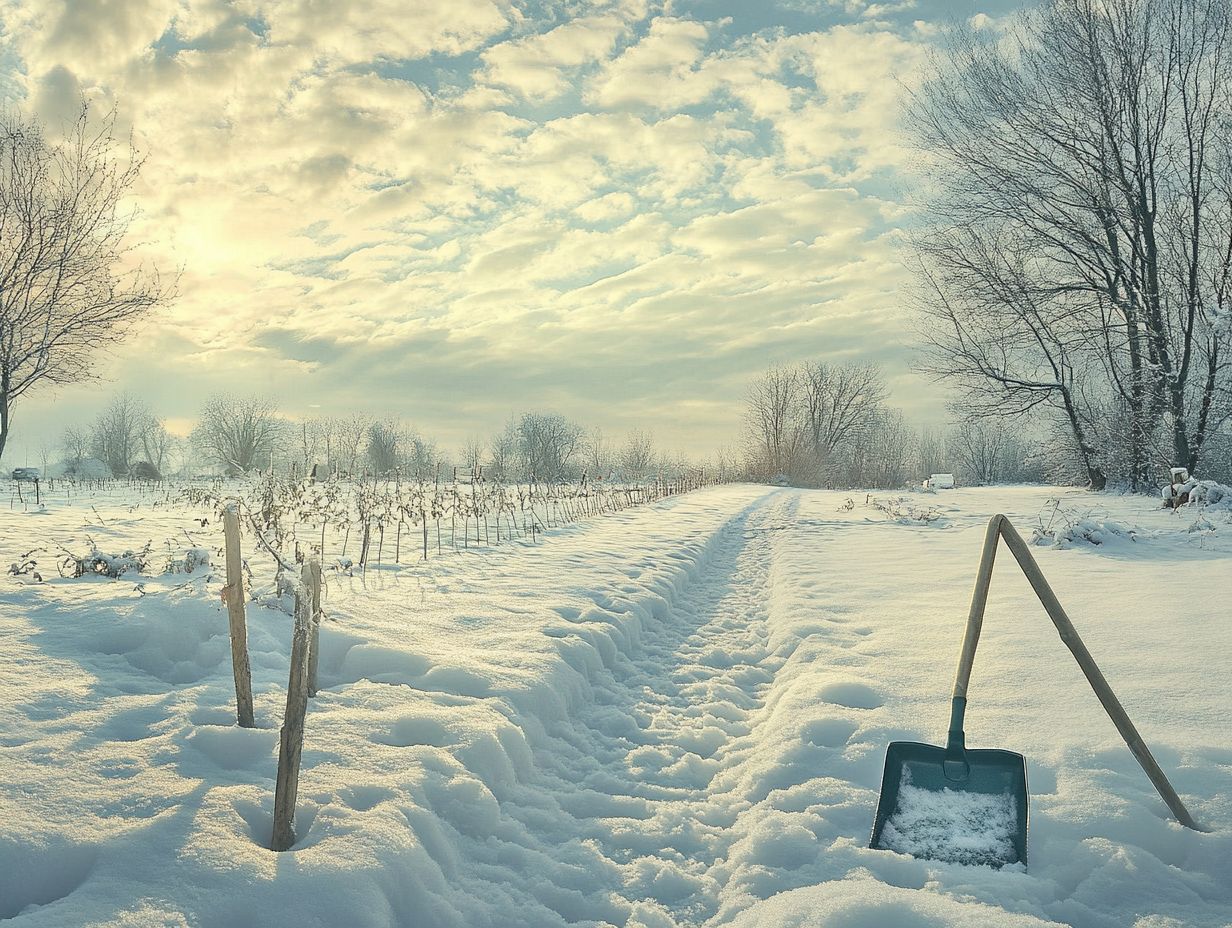
Proper storage and transportation play a crucial role in preserving the quality, flavor, and nutritional value of winter crops. This ultimately impacts consumer satisfaction and market appeal. By ensuring that your crops are stored and transported correctly, you can significantly reduce waste.
Take root vegetables, for example. Carrots and potatoes thrive in a cool, dark, and moist environment to stave off dehydration and spoilage. In contrast, leafy greens like kale require higher humidity levels to maintain their crispness and freshness. By paying close attention to these storage conditions, you enhance the taste and ensure that these crops retain their nutritional benefits for consumers.
Efficient transportation methods further bolster these efforts. They minimize delays and temperature fluctuations during transit, ensuring your vegetables arrive at markets in peak condition. When you prioritize these practices, you greatly enhance your chances of establishing a strong market presence.
Act now to ensure your crops thrive!
What Types of Equipment Are Necessary for Proper Storage and Transportation of Winter Crops?
For proper storage and transportation of winter crops, you need insulated containers, refrigerated storage units, and transport vehicles. Choosing the right equipment is key to keeping your crops fresh as they travel to market or storage.
Insulated containers prevent temperature changes and protect against moisture. This ensures your crops stay fresh.
Refrigerated storage units with precise temperature controls extend the shelf life of delicate produce. For transport, use vehicles with adjustable temperature settings to meet the unique needs of different vegetables.
Don t forget to consider the sensitivity of your crops to ethylene gas, a natural gas that can speed up ripening. Choosing the right equipment helps maintain quality from field to market.
How Can You Maintain and Clean Your Storage and Transportation Equipment?
Maintaining and cleaning your storage and transportation equipment is vital for ensuring that harvested winter crops stay uncontaminated and fresh. This directly influences their quality and shelf life.
Regular maintenance practices help you avoid equipment breakdowns and extend usability. To boost efficiency and minimize spoilage, develop a comprehensive cleaning schedule that includes thorough inspections.
Implement best practices, such as sanitizing surfaces with the right cleaning agents and monitoring humidity levels. This significantly enhances the longevity of your equipment.
Training your staff on the importance of proper handling techniques is crucial to prevent contamination during transport. By incorporating these actionable steps, you can maintain optimal conditions that protect the integrity of your crops.
7. Crop Monitoring and Management Tools
Effective crop monitoring and management tools are essential for maintaining the health and productivity of your winter crops. These resources enable you to track growth and swiftly address any issues that arise.
By harnessing technology and best practices, you can enhance plant care, ensuring your vegetables thrive even in challenging winter conditions. These tools optimize your yield, offering real-time data collection and analysis.
For example, soil moisture sensors help you maintain ideal moisture levels, while thermal cameras provide insights into plant health, pinpointing areas that may be overheating or lacking light.
Educational resources that teach about integrated pest management and crop rotation techniques can significantly elevate your overall crop performance. Embracing these technological solutions and learning opportunities allows you to adapt your strategies for winter crops.
Why Is Monitoring and Managing Winter Crops Important?
Monitoring and managing your winter crops is crucial for maintaining plant health and optimizing growth. It enables you to identify potential problems early and make informed decisions to mitigate risks.
By adopting a proactive approach, you can significantly enhance the success rate of your winter vegetable garden. Without oversight, issues like pest infestations or nutrient deficiencies can lead to diminished yields or even crop failure.
For example, if you neglect to check for aphid populations, these pests can multiply quickly and undermine the health of your plants. Timely intervention, such as implementing integrated pest management strategies or adjusting fertilization schedules, helps correct these issues.
This not only promotes increased resilience among your plants but also leads to a more bountiful harvest, transforming your efforts into rewarding results.
What Types of Tools Are Available for Monitoring and Managing Winter Crops?
Many tools are available to help monitor and manage winter crops. These include soil moisture meters, temperature sensors, and crop management software.
Each tool provides insights that improve your decision-making. Using them can enhance your winter crop management strategies and lead to better results.
These technologies allow you to keep a close eye on factors that affect crop health, such as nutrient levels and weather conditions. Soil moisture meters give you real-time data on soil hydration, helping you to water your crops efficiently.
Temperature sensors track weather changes, ensuring your crops are protected from frost damage. Crop management software gathers this data into easy-to-read dashboards, helping you plan and act swiftly.
Using these advanced tools optimizes your farming methods and strengthens your resilience against the unique challenges of winter gardening.
How Can You Use These Tools Effectively for Winter Crop Care?
To use monitoring and management tools effectively for your winter crop care, you must master interpreting the data they provide. This knowledge will help you enhance growth conditions.
Collect data on soil moisture, temperature, and nutrient levels. Analyze this information to uncover patterns that impact your crop performance.
Regularly integrating these insights into your gardening routine allows for timely adjustments. You can optimize your irrigation schedules and fine-tune your fertilization plans.
Using visual aids, like charts and graphs, simplifies complex data, making it more accessible. By weaving these strategies into your gardening approach, you can cultivate a more resilient and flourishing winter garden.
8. Safety Equipment
Safety should be at the forefront of your winter crop care strategy. The challenges posed by cold weather can increase the risk of accidents while you work in the garden.
By using the right safety equipment and following essential gardening tips, you can create a safer environment for yourself and your crops. Consider a selection of safety gear:
- Insulated gloves to shield your hands from the biting cold,
- Non-slip footwear to help prevent falls on icy surfaces,
- Thermal clothing layers to keep your body warm.
It s also crucial to have a first aid kit ready and a reliable source of light for those shorter days.
Emphasizing best practices for accident prevention like regularly checking your tools, staying hydrated, and taking breaks can help reduce the chances of mishaps.
Integrating gardening education into your seasonal safety protocols equips you with the knowledge needed to navigate the unique challenges of winter gardening confidently.
Why Is Safety a Priority in Winter Crop Care?
Safety should be top of mind when tending to winter crops. The cold weather brings heightened risks and physical demands while gardening.
The frost-covered ground can be particularly treacherous, presenting slip hazards that could lead to falls. Low temperatures can impair your vision, making it harder to detect dangers like exposed roots or scattered tools.
The risk of hypothermia or frostbite increases when you’re outdoors without proper protection. These dangers jeopardize your health and can negatively influence your crops, as stressed plants become more susceptible to diseases and pests.
Exercising caution is vital not just for your safety, but also for the health and productivity of your winter crops.
What Types of Safety Equipment Are Necessary for Winter Crop Care?
Necessary safety equipment for winter crop care includes insulated gloves, safety goggles, and appropriate footwear, all crafted to shield you from the unique hazards that arise during the winter months. Equipping yourself with the essential tools for winter gardening success can significantly diminish the risk of injuries as you tend to your crops.
The chilly temperatures create slippery surfaces and hidden dangers, making protective gear critical. Insulated gloves will keep your hands warm and functional, allowing for a better grip and dexterity when you re handling tools or seed trays.
Safety goggles are essential for protecting your eyes from flying debris or snow, enhancing your visibility during those winter tasks. Opting for waterproof and insulated footwear ensures your feet stay warm while preventing slips in icy conditions, keeping you stable and secure.
Proper gear not only boosts your comfort but also instills confidence, allowing you to concentrate on the vital tasks of winter gardening without the looming worry of accidents or injuries.
How Can You Ensure the Safety of Yourself and Others While Caring for Winter Crops?
Ensuring your safety and the well-being of others while tending to winter crops requires you to adopt best practices that prioritize health and welfare. This includes maintaining a clean working environment and effectively using safety equipment.
By fostering a culture of safety, you can create a more positive experience for yourself and your team. To further enhance safety in winter crop care, it s vital to implement organized sessions where everyone learns how to stay safe.
Encouraging open communication about safety concerns enables your team members to take responsibility for their own well-being and that of their colleagues. Conducting regular safety audits of equipment, protective gear, and storage areas will help you identify risks and ensure a proactive approach.
By organizing workshops that showcase best practices in winter gardening, you can keep your team informed and better prepared to efficiently handle emergency situations.
9. Equipment Maintenance and Repair
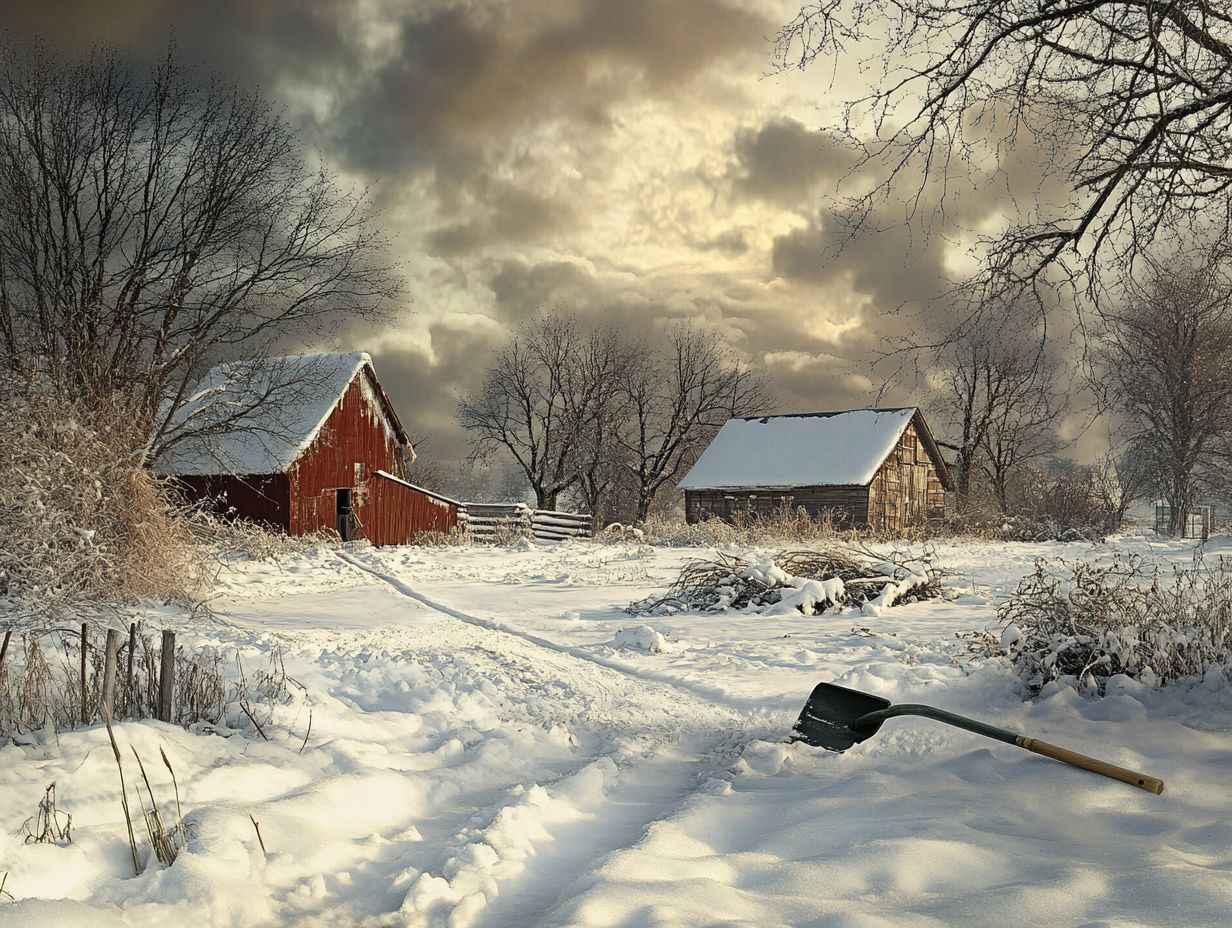
Proper maintenance and repair of your winter crop equipment are crucial for ensuring that all your tools and systems function seamlessly, directly influencing the success of your winter gardening endeavors. To enhance your efforts, consider the top 10 must-have tools for winter gardening. By regularly checking and making timely repairs, you can prevent potential gardening challenges that may arise from malfunctioning equipment.
This meticulous attention to detail not only saves you time and resources but also nurtures a healthier growing environment. As a gardener, you should prioritize tasks like:
- Inspecting and sharpening the blades on tools such as pruners and shears
- Cleaning and lubricating moving parts
- Checking for leaks in hoses and irrigation systems
Testing and recalibrating heating systems for your seedlings, along with ensuring optimal storage conditions for seeds and fertilizers, can significantly boost your productivity. A proactive approach to maintenance will ultimately lead to thriving crops, even in the most challenging winter conditions.
Why Is Proper Maintenance and Repair Important for Winter Crop Equipment?
Proper maintenance and repair of your winter crop equipment are vital for ensuring the long life and performance of your tools. Using the essential tools for winter garden prep directly influences the success of your gardening efforts during the colder months. Neglecting maintenance can lead to problems and inflated costs over time.
Keeping your equipment in optimal condition allows tasks like tilling, planting, and harvesting to proceed seamlessly, minimizing any potential downtime. Regular inspections can help you identify worn parts before they escalate into major issues. This ultimately saves you both time and money.
For instance, sharpening blades on hoes and pruners boosts cutting efficiency. Routinely checking fuel levels and changing oil can prevent engine troubles.
Cleaning away debris to avoid rust and corrosion is essential for the long life of your machinery. Investing a little time in these easy maintenance tasks will pay off big! You ll ensure that your winter gardening operations run like a well-oiled machine, maximizing productivity even in the coldest conditions.
What Are the Essential Maintenance and Repair Tasks for Winter Crop Equipment?
Essential maintenance and repair tasks for your winter crop equipment include regular cleaning, inspecting moving parts, and replacing worn components promptly. For more effective gardening, consider the essential winter gardening supplies you need. These tasks are designed to ensure optimal performance when you need it most. By prioritizing these tasks, you can enhance the efficiency of your gardening tools and systems.
Your comprehensive checklist should include checking fluid levels, inspecting electrical systems, and adjusting equipment settings for precise configurations.
Scheduling these tasks well before the planting season is crucial. A detailed timeline can help facilitate timely interventions, ensuring your equipment is ready to go when the planting window opens. For example, if you set aside time for inspections in early fall, you ll have the opportunity to address any necessary repairs before harsh winter conditions make access challenging.
Incorporating these maintenance tasks into your routine operations not only ensures that your equipment performs optimally but also extends its lifespan. This ultimately reduces costs and maximizes productivity during the busy growing season.
How Can You Properly Maintain and Repair Your Winter Crop Equipment?
Properly maintaining and repairing your winter crop equipment requires a step-by-step plan that includes regular inspections, effective cleaning techniques, and timely repairs. To ensure you have everything necessary, consider the key winter gardening supplies you need. This diligence will extend the life of your tools, ensuring that your equipment is always ready for action when the growing season rolls around.
One effective strategy is to create a tailored maintenance schedule for each piece of equipment. This allows you to conduct targeted inspections based on usage and the manufacturer s recommendations. For example, make sure your cultivators and seeders undergo thorough checks for mechanical wear and tear before planting season begins. Meanwhile, your irrigation systems should be cleaned and tested to prevent leaks.
Consider implementing protective measures, like storing your equipment in a dry, sheltered location to shield it from harsh winter elements. Plus, having basic repair kits on hand can save you valuable time. They help you tackle minor issues quickly, preventing them from developing into major setbacks.
Frequently Asked Questions
What is considered essential equipment for winter crop care?
The essential equipment for winter crop care includes shovels, snow blowers, tractors, plows, and heaters.
Do I need to invest in specialized equipment for winter crop care?
It is recommended to have specialized equipment such as heated greenhouses or frost cloths for more delicate crops. Additionally, having the right tools, like essential thermometers for winter gardening, can also help ensure basic equipment gets the job done.
How often should I use my equipment for winter crop care?
The frequency of use depends on the weather and the condition of your crops. Don t wait! Check your crops regularly to ensure they thrive!
Are there any safety precautions I should take when using equipment for winter crop care?
Always wear appropriate protective gear and follow manufacturer instructions when using equipment. It is also important to regularly maintain and inspect equipment to ensure safe operation.
Can I rent equipment for winter crop care instead of purchasing it?
Yes, you can rent fantastic equipment like tractors and snow blowers!
Don t miss out check with your local rental company for the best availability and rates.
What should I do with my equipment after winter crop care season is over?
Make sure to clean your equipment well and store it safely in a dry location.
This will keep it in top shape and ready for next winter. Schedule any maintenance before you store it away!

